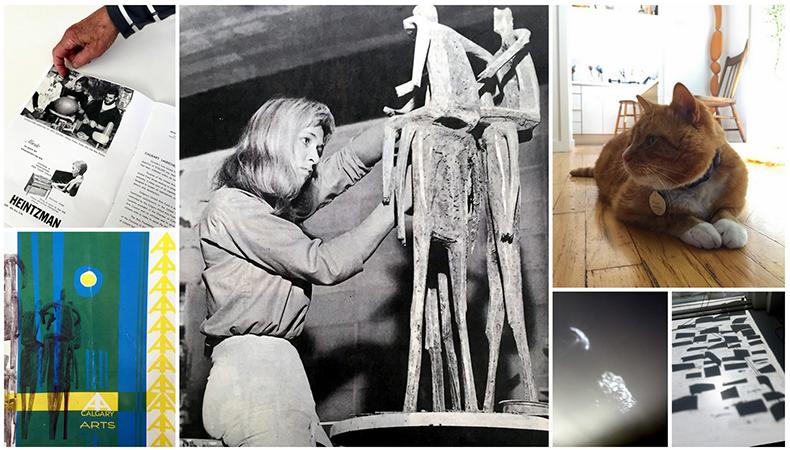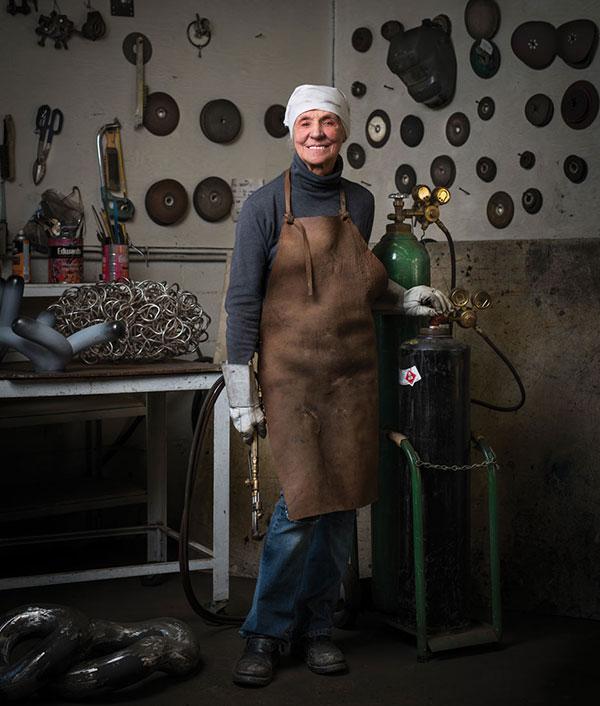KATIE OHE, DIPLOMA, 1960
ALUMNI DISCOVERY INITIATIVE INTERVIEW BY MORGAN SCULLY

In the summer and fall of 2015, I interviewed Katie Ohe for the ACAD Alumni Discovery Initiative program. I can’t include a lot in this interview that isn’t already known about Katie or demonstrated by the impressiveness of her CV, and while I will attempt to describe what it was like to look through boxes of work in her studio, sit with her on her living room floor or watch her take a seat at an ACAD Cafeteria table, recounting the greatness of these experiences is probably somewhat inexpressible too.
The first time that I interviewed Katie Ohe, I spent a day at the Kiyooka Ohe Arts Centre with her, walking from Harry Kiyooka’s studio to hers, through their yard, their sculpture garden and into their house. Weeks later at ACAD, we sat down in the Cafeteria to have an interview follow-up. Katie used a paper plate to scoop up remaining crumbs left by a former eater. The way that Katie used the paper plate was reminiscent to me of how she’d handled everything in class (I took two Sculpture courses from Katie). Her hands portraying the immediate connection and coordination of object, vision and mind while existing as vehicles for the intentions that they carry out, always deliberate, meaningful and strong, demonstrating to me “how something is” or “how to make something different”.
Back, sitting on Katie’s living room floor, we talked about her family. Katie grew up on a farm near Peers, Alberta. Her homesteading parents led a busy and harsh farm life, and caring deeply for the welfare of their children (2), education was paramount. She reflects on herself as a child, as being an unrestrained visionary, highly imaginative and motivated, always creating things. She imagined that her future was to become an artist. Her parents conveyed their consent and support when she left the farm to study art, by telling her that “you must become what you are”.
At this point in the conversation, I wished that everybody could hear Katie talk about art. To me, it’s like art was a magical force that chose her, but she corrected me. Art is central to her life, “it is a privilege, it is a ‘gift’. All artists are ‘gifted’.”
The Alumni Discovery Initiative questions are intended to focus on someone’s relationship to ACAD and Katie’s relationship with ACAD is whole, encompassing student, alumnae, instructor and mentor. Katie graduated from ACAD (P.I.T.A.) as a painter in 1958. Due to a lack of students, a Sculpture Department didn’t yet exist. Though she remarked that after Kenneth Sturdy loaned her his wood carving tools, her hands became like hamburger, “I fulfilled my painting requirements, however all faculty supported and mentored my artistic passion to be a sculptor, I was encouraged to shape my canvases”.
Katie studied under ACAD art instructors whose names now title our College, Marion Nicoll, Luke Lindoe, Stanford Perrott and Illingworth Kerr. During her time as a student, Marion Nicoll recommended Katie and applied on her behalf to the Montreal Museum School of Fine Art (1958 – 1959) where she became one of eight Canadians to study child-art education for a year with Dr. Arthur Lismer (Group of Seven). Katie then taught child-art for the Calgary Allied Arts Centre from 1960 to 1968. The summer before Montreal, with the help of Luke Lindoe, Katie worked for Ceramic Arts. “It was a privileged learning experience, I learned a great deal, primarily doing preparation work such as preparing clays, glazes, loading and unloading kilns, mopping up. I was working with established, professional potters like Walter Dexter, Walt Drohan and Luke Lindoe.”
Support given by Archie Key (Allied Arts Centre) and Marion Nicoll, led Katie to take her post-graduate study at the Sculpture Centre in New York for three years 1961 – 1963, “I was awarded free tuition, and considerable support from the Sculpture Centre.” Katie would return to Calgary during the summers to resume teaching for the Calgary Allied Arts Centre.
A Canada Council Grant, 1969 – 70 took Katie to a studio study workshop in London, England for a year. She spent six summers (1972 to 1978) working in bronze foundries by invitation in Verona, Italy supported by the Sculpture Centre.
As I interviewed Katie, she taught me about concept, strategy, structure and material. She stated that her sculpture has always been abstracted, never classical. “My preferred working method is to construct, fabricate or to model with materials, I have carved, stone and wood, have enjoyed the process, but found, my thought and working process, as a work evolves, tend to be from the inside out (modelling) not outside in, as in carving. The most difficult part of my practice in sculpture is to commit to an ‘idea’, to give shape, and material to that idea. I have to believe it, to see it, to do it, colour and surface is equally significant.” Katie works primarily in metal, therefore we discussed safety. She confessed to be practiced and experienced with her tools and the applied studio safety measures, even considering pet safety.
We started talking about Katie’s modelled, clay, fired heads (portraits) which she has worked on, off and on, since the 1960s. Clay allows her to work in a specific way, as it is an immediate, tactile and impulsive material. “Initially, to model portraits meant for me, a practice of seeing, and interpreting, clay was the choice material. Eventually, I questioned, how I really wanted to portray my subject. It is the expression, the essence of the subject, not the surface that I wish to capture, this is what I continue to seek, and practice.” (I.e. The head of John Snow (commissioned) became 14 attempts before Katie reached a satisfaction.)
I asked Katie a standard Alumni Discovery Initiative question. What would you like to be recognized for? She said that that thought had never entered her mind, “it is a privilege to do, and be creative. I am fortunate to be connected, as an art educator, and to be able to retain a balance of teaching and personal studio practice.”
“Stay connected,” is what Katie said when I asked her what ACAD should do for its alumni. Continuation is very important as a support structure, as an artist and as a mentor. As she talked about advising, what ACAD should do and does do, she unintentionally began to advise me. “Originality sustains you, study, guard your creative time, develop your creative strength, diversify, experiment, take risks, evolve, meet and elevate your own expectations. Don’t necessarily depend on your work to support you.”
With a CV listing 16 public sculpture commissions, 12 solo exhibitions and 25 group exhibitions, it was a true privilege to spend time with Katie, walking around her property, talking about anything that I wanted to and sharing sushi. I spun “Weeping Bees”, I opened “Family Box” and I stood beside “Montava Arch”.
Marion Nicoll, Luke Lindoe and Illingworth Kerr all encouraged and supported Katie as mentors and advisors throughout her study at ACAD (P.I.T.A) followed by years of post-grad study elsewhere such as New York, London and Verona. Katie’s advice for ACAD, with its students and alumni, echoes the same support that she was granted. “Provide the students with humane and artistic support. When, and after they graduate, they will contribute by reputation.” Katie continues to honour the Alberta College of Art + Design for her artistic growth, her beginnings, and on-going support from there.
